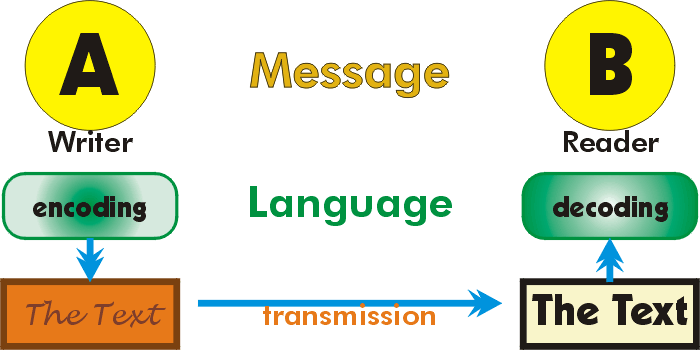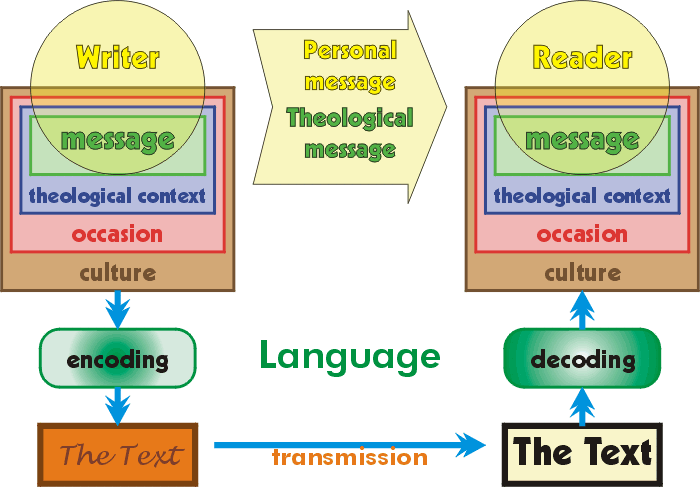2 - A model for Hermeneutics
Hermeneutics is the name that theologians use for the principles for Biblical Interpretation. In many Bible schools, courses on Biblical Interpretation are called hermeneutics. It is just a shorter word for the same thing (however it is also used in a wider sense for any kind of interpretation of a piece of art or literature).
What is Hermeneutics? Part A
The Goal of this course:
- “To understand the Scriptures better in our times.”*
Explanation:
| to understand | There should be no distinction between the head and the heart (in the Bible the heart is the place of deep thoughts, not emotions) |
| the Scriptures | i.e. “written”, by men and by God. We need to understand both in order to perceive the message. If we are not in fellowship with God, we will never understand it properly |
| Better | If we think that our theological systems are perfect, then we are never going to learn. Humility is one of the main prerequisites for understanding |
| in our time | Obviously the truth of God does not change, but we do not apply it in the same way as in Calvin’s time. They did not encounter abortion, evolution or pluralistic societies. |
Hermeneutics is Necessary
- Because of the authority of the Bible. (How can it exercise authority unless it is understood?)
- God does not “zap” us with instant understanding of all he wants us to know
- The Scriptures come in a earthly languages, with all the grammar & syntax that entails. In his wisdom, God chose Hebrew & Greek!!
- There are large differences in belief between Christians who believe the same Bible.
Hermeneutics is Possible
- Some have said that it is not possible for even two humans to have real communications. They write papers to prove this!!!
- Post-modernism, reader-response hermeneutic etc.
- Although there is a large historical and cultural distance between us and the original authors, we can bridge it because:
- Of the unity of mankind—we are one
- Human nature does not change
- God is still sovereign in history, even as he was then.
- The linguistics insights of Noam Chomsky (that all humans have a built-in “organ” in their brains, designed for the express purpose of communicating with each other by language) have strongly supported this position.
Interpreting and understanding.
Two models of Hermeneutics:
- Understanding the text: scientific analysis

There is a danger that the text can become autonomous and cut loose from the intentions of the author, especially the divine author. The focus is on a study of the text itself. People talk of “creative interaction with the text”. Even evangelicals can be guilty of this. They can be more interested in being “blessed” by a devotional reading than in finding out what God has said.
- Understanding the author: communication

There is a subtle but profound shift. The goal is to receive a message that has been communicated to us. The text is reduced to a medium, and not exalted above the author.
The transmission
- We do not have the original autographs in our possession.

- Textual criticism is a very complex subject, but
- No important doctrine is in any doubt
- The amount of textual evidence is astounding (compared with other ancient books)
- The level of agreement is remarkable
The Code
All communication has to be encoded in some form, (unless we are telepathic).
- Humans usually use a form called “language”
- This is not the only code we can use
- Most societies have developed a written version of the code
- Sometimes it is unrelated to the spoken sounds (Ancient Egyptian, Chinese)
- A language has some kind of:
- vocabulary
- grammar
- syntax
- There have also developed meta-structures such as
- paragraph
- subheading / subsection
- work
- document structuring (e.g. introduction / body / conclusion)
- Another development is genre, such as:
- narrative
- poetry
- letter
- Each genre has meta-structures appropriate to it
| Very important: The privilege of defining the code is the privilege of the writer |
Lewis Carol was making a very serious point.
- So, when you come to read a parable, or the book of revelation, you are not free to interpret the symbols how you wish. The human & divine authors have the privilege of defining what the terms mean. You can’t say “I like this idea.”
- Preachers sometimes say “I like the way this translation says it”. What they like is irrelevant—it is the translation that captures the intention of the author which should interest us.

*(with thanks to Dr. Amar Djaballah)
Updated 2009-10-12 (build:16) by Andrew Fountain
What is Hermeneutics? Part B
Models of Hermeneutics cont’d
- Now we add in some more levels of complexity
- context
- culture
- occasion
- theological system within which the writer is operating
- personhood
- the human author (whom we cannot know, but can learn to appreciate)
- the ultimate divine author

It is really important to see that the Scriptures are fully human and fully divine at the same time.
If we leave out one of these, it will distort our interpretation
Questions to ponder?
- are the two kinds of message ultimately different? What is the difference between them?
- are they both limited to propositional truth?
- is there a need to study the culture / occasion etc. of the reader?
- are the boxes necessarily within one another?{theological content of a book often transcends the occasion, but must be studied in its context}
- to what extent can the writer transcend the boxes?{human cannot, but divine can}
- is there truth in the literary form, or only in propositions?
- Short Defn of Biblical Theology
“Biblical Theology allows the Scriptures to provide not only the content but also the structure of our theology.” - it does this by looking for structure and organization already there within God’s revelation, such as development through time, collections of writings from a single author, structured presentations of truth within a book, and literary features.
- Short Defn of Biblical Theology
Updated 2009-10-09 (build:9) by Andrew Fountain
Overview of Assignments: Studying a passage of Scripture
Part 1: Language and Culture
- 1.1 Select An English translation
- 1.2 Two word studies using words taken from your passage
- 1.3 (Grammatical & Literary Study)
- 1.4 (Cultural/Historical Insights to Passage)
Part 2: Larger Context (Background and Purpose of Book)
- 2.1 Occasion (circumstances) of writing
- 2.2 Purpose of the book
- 2.3 Outline of book
- 2.4 Purpose for this passage within the book
Part 3: The Message
- 3.1 Statement of the basic steps of reasoning within the passage
- 3.2 Which covenant period is the passage under?
- 3.3 Verse by verse explanation/interpretation
- Use Biblical Theology (e.g. compare with parallel passages)
- Use Systematic Theology (e.g. similar or contrasting teachings in Scripture)
- Point out any quotations of the Old Testament in the New
- Discuss alternative interpretations and give your preferred interpretation
- 3.4 Conclusions regarding the teachings of the passage
Part 4: Response
- 4.1 The Response Required from the Original Hearersand The Response Required Today
- 4.2 Personal Response
Updated 2009-10-07 (build:7) by Andrew Fountain